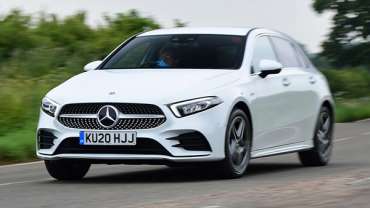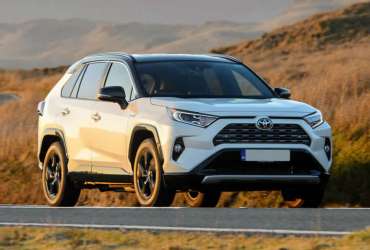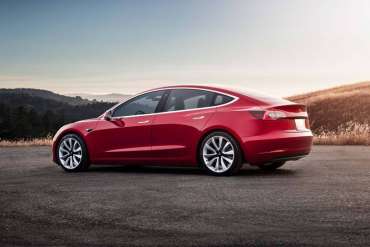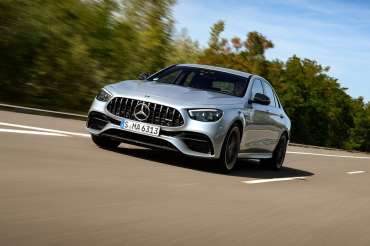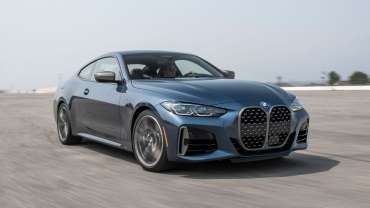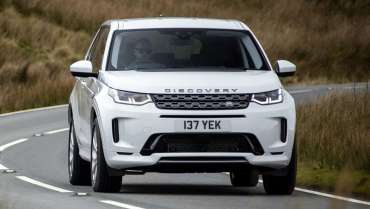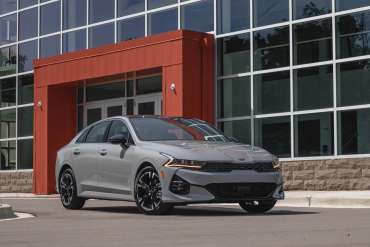
Worldcarblog.com
2021 Mercedes-Benz A 250 e AMG Line Premium Review
The numbers alone make the A 250 e hugely appealing as a company car, while the fuel savings and fantastic interior will be just as tempting for private buyers. We hope that the quality issues our test car suffered were an isolated thing, but we would prefer a slightly more forgiving ride. Even so, this PHEV remains one of the highlights of the A-Class range.
We’ve been used to exaggerated fuel economy figures for years, and things don’t seem to have improved with the ranges manufacturers claim for electric cars either. So surely Mercedes’ declaration that its new plug-in hybrid A-Class could average over 250mpg and run on electric power for 44 miles is pie in the sky? Let’s see…
Most plug-in hybrids will struggle to get near the 30-mile mark their makers claim, so 44 miles is quite a challenge. But Merc’s answer is to give its baby a 15.6kWh battery – hidden where you won’t notice (until you fill up the smaller-than-usual 35-litre fuel tank) – and a turbocharged 1.3-litre four-cylinder petrol engine. Total power output is 215bhp, meaning the A 250 e’s 0-62mph time is a swift 6.6 seconds.
But what about those fuel economy figures? Of course, it all depends how you drive, but for our test of the car, we took a varied route over a mix of motorway, fast A-roads and urban stuff – further than the average driver will cover in a day.
We started with a full charge, although the range display only read 34 miles, possibly down to how the Merc had been driven before we got our hands on it. Of the first 30 miles we drove, the read-out showed that 28 of them had been covered on electric power, with the average fuel economy displayed on the read-out at its maximum of 99.9mpg and electric usage at 4.1m/kWh – both pretty impressive.
The range read-out showed 12 miles still to go, too, meaning a theoretical range just two miles shy of the 44-mile claim.
To be honest, if it hadn’t been for us being a bit forceful with the throttle to get the petrol engine to kick in, we suspect a whole 30-mile journey could be covered on electric power – and that means those huge economy claims are almost in reach for a great many people, as long as they plug their car in to charge regularly.
Plus, if your home energy costs no more than 13p per kWh, your first 40 miles will cost you a couple of pounds – less than half what you’d pay in a petrol-powered A-Class.
Then there are the company car tax savings, which will appeal to many. With its 32g/km figure and 44-mile range, you’ll only pay tax on 8 per cent of the P11D value (or just 6 per cent for the basic AMG Line version) versus a whopping 29 per cent for a petrol A-Class. Sure, your company will have to pay at least £32,925 for the cheapest A 250 e, but it could slash your company car tax liability by around a third.
The driving experience is a mixed bag, though. On electric power alone, the car is swift and quiet, as you’d expect. And when the engine kicks in, it doesn’t get that much rowdier unless you’re using plenty of revs, when things can get unpleasantly loud.
However, the throttle is super-sensitive and the lumpy eight-speed dual-clutch gearbox can make you think that the engine is cutting in even when it’s not. In electric mode, the power goes through the eight-speed DCT automatic gearbox, which is jerky going from first to second and feels as though the engine has fired up. You get the same kind of slight tremor you get when an engine cuts in, but it’s actually the gearbox just switching gears.
Really, the engine is only there for when battery power has run out. In most everyday driving situations, electric power will do just fine – even on the motorway at the legal limit. But if you want to match the exciting 0-62mph time, you’ll need to have both power sources working in tandem.
All four versions of the A 250 e come in sporty AMG Line trim levels, but they fail to match the fun of the full-bore AMG models. These aren’t the best A-Classes through bends by a long chalk, but they do an okay job as family transport.
Space is good in the front and back, the doors open wide to reveal decent access, all-round visibility is great, and the 345-litre boot will certainly be big enough for most buyers’ needs.
The A-Class is an easy drive, but not very rewarding: the steering responds okay, but has little feedback from the road, and while the tyres grip okay, they’re noisy – which is amplified by the quiet EV powertrain.
We were more disappointed with the ride, especially as our car had Comfort suspension. It’s not too uncomfortable, but other small hatches ride better.
More of a problem in the test car that we drove was the shiver that ran through the body and the subsequent rattles every time we went over cats’ eyes or hit a mild pothole in the road. It’s certainly not what you’d expect from a Mercedes.
Especially one with what is the best interior in any small car bar none. Our AMG Line Premium model comes in with a price of £35,980 – not too far from a fully electric Kia e-Niro. But as standard the Merc comes with the fabulous, seamless twin 10-inch screens, augmented-reality satellite-navigation that overlays directions on a live feed from a front-facing camera, wireless phone charging and the very latest in smartphone connectivity.
Above all, the cabin looks and feels high-end. There’s heated sports seats with red stitching, multi-coloured ambient lighting, a touchpad to run the infotainment (mirrored by touch-sensitive buttons on the wheel), aluminium trim and turbine vents.
Outside there’s a subtle AMG bodykit, smart 18-inch alloys and LED headlights – all of which doesn’t make the price seem too exorbitant, especially with the potential savings on tax and fuel.
Source: mercedes-world.com
Toyota RAV4 Review
The Toyota RAV4 is a practical family SUV that has a roomy cabin, plenty of standard equipment and an economical hybrid system, but alternatives have tech that’s easier to use.
Overall verdict
No one really thinks of the Toyota RAV4 as a trailblazer, but that’s what it is, because back in 1994 it was the first of the small ‘leisure SUVs’ that preceded the tsunami of such vehicles we see today.
One thing that hasn’t changed over the years is the fact that the RAV4 remains an affordable family SUV with a spacious cabin, a big boot and a clever hybrid system.
These days the RAV4 has a wide range of alternatives, such as the Honda CR-V and VW Tiguan, but in its latest form stands out from these cars thanks to its super-aggressive looks.
The Toyota RAV4 is a mishmash of creases, angular shapes and blunt surfaces whichever angle you approach from. Its gaping octagonal grille looks more like it belongs on a menacing sports saloon than a practical family runabout. You might like it, but your neighbour might not, or vice-versa. In any case, it’s certainly striking.
Sadly (or not, depending on your view) the Toyota RAV4 is less daring inside. It combines simple surfaces, clean lines and posh-looking metal-effect trims that look pretty understated and rather classy and most of the surfaces you’ll touch regularly feel plush and sturdy. It’s not quite as solid-feeling as a VW Tiguan, but it looks much more exciting than a Honda CR-V.
One area of improvement is the infotainment system, which now features Apple CarPlay and Android Auto. The system is much quicker to respond than systems of old.
The seats are very supportive; in mid-range models, you get lumbar support and plenty of electric adjustment that means even taller folk will find space to stretch out.
If you’re designated driver for a burly five-a-side football team then everyone will fit in just fine and even entry-level cars will allow you to recline the seat backs by a few degrees.
You won’t break a sweat fitting a child seat either – the Isofix points are easy to find – and a wide opening and flat floor means sliding things into the Toyota RAV4’s boot is an easy task.
There is more room than the boot in the Honda CR-V and, even though there are no levers in the boot to do so, you can flip the back seats down flat to carry really big stuff – such as a bike.
The simplicity extends to the engine range and driving experience, too. The only engine option is a hybrid system and this lets you cruise almost silently around town using just the power of its electric motor. You get an automatic gearbox as standard, too, which means you can cruise around town without constantly reaching for the gear lever.
The downside of the auto ‘box is that it makes the 2.5-litre petrol engine rev loudly every time you put your foot down. It’s reasonably quiet when you’re cruising at motorway speeds, though, and the RAV4 irons out bumps pretty well, too. As an added bonus, you shouldn’t have too much trouble getting close to Toyota’s top claimed fuel economy figure of 50.4mpg.
The relaxation stakes are further upped by the driver assistance features that make the Toyota RAV4 relaxing to drive for long periods and help prevent avoidable accidents – perfect if you’re looking for a safe family SUV that’s easy to live with every day. If you are after something that offers a touch of entertainment then the SEAT Ateca is more fun to drive, though.
By going hybrid the RAV4 has taken a few more small steps for mankind and if it sounds like your next car, take a look at the latest Toyota RAV4 deals or get offers from our favourite model – the hybrid model in Design spec – by clicking the button below.
Style
The Toyota RAV4’s interior might be laid out in a simple and sensible style but it certainly looks more modern than the rather plain look of the VW Tiguan’s cabin. The Toyota gets swathes of soft, squidgy plastics across the dashboard and doors, and plenty of aluminium-effect trims on the steering wheel, door handles and around the air vents.
The infotainment display is a freestanding affair that sits high up on the dashboard rather than built-in lower down so it’s easy to glance at while you’re driving. It manages to look rather more integrated than other similarly high-riding screens (like the one on the Ford Kuga for example) thanks to some surrounding chrome trim that extends down onto the lower part of the dash.
The cabin features a few hard, brittle plastics – most notably on the grab handles, around the glovebox and below the central armrest – but, generally speaking, the RAV4’s cabin feels pretty plush and suitably solid. The chunky air conditioning knobs are easy to use too, but the heated seat switches are tucked away under the dashboard.
Icon and Design models get black cloth seats while Excel versions get black leather seats and suede-like Alcantara door trims. Top-level Dynamic cars get a faux-leather seat covering with contrasting blue stitching but there is a variety of different leather colour options available on all the trims.
Infotainment
Every Toyota RAV4 comes with an 8-inch touchscreen infotainment system as standard, although what that system can do differs depending on which model you go for.
Regardless, the screen is bright and relatively easy to read in direct sunlight, but it isn’t as sharp as the screen you get in a VW Tiguan and isn’t as easy to use quickly while on the move.
The array of physical shortcut buttons are a bonus, though, and they will help you switch between the features you’ll use most often. There are also two easily reached physical dials for the stereo volume and radio tuning.
Turn attention back to the screen and the home menu is very difficult to decipher. It displays a window for the sat-nav, one for the stereo and a third showing you the status of the hybrid system, but they’re so jumbled together you’ll have real trouble reading them or following directions.
If you want the aforementioned satellite navigation then you get it as standard so long as you avoid the entry-level Icon model. It’s relatively easy to pop in an address and add a waypoint, but the maps themselves aren’t particularly clear.
Sure, the graphics are nice and bright, but the system defaults to a very wide zoom which makes spotting upcoming turns rather tricky. You can zoom in manually, but only using the on-screen buttons. Using a pinching motion, which you would on a smartphone, means that the map stops following your progress and stays in a fixed position.
However, if you would rather use one of the navigation apps on your phone then you get Apple CarPlay and Android Auto as standard on all models. You can also use the standard Bluetooth connection to play music from your phone through the car’s stereo, or there’s an aux-in socket if you want to link up using a cable.
Speaking of stereos, you get a fairly nondescript six-speaker system as standard but Excel and Dynamic cars come with the option of an upgraded nine-speaker JBL unit with subwoofer in the boot to deliver clearer, punchier bass notes. It certainly sounds better, but alternatives come with even more impressive stereo upgrades.
Source: carwow.co.uk
Tesla Model 3 (2020)
Now in its fourth model year, the Tesla Model 3 manages to be efficient, luxurious and fun to drive. For those reasons and more, the Tesla Model 3 is Edmunds' top-rated Luxury Electric Vehicle for 2020.
You can configure a Model 3 to maximize what you want, whether it be a low price, long range or high performance. And in every iteration, the Model 3 gives you access to Tesla's proprietary Supercharger charging network and some of the best semi-automated driving assistance features around. Of course, the brand cachet the Tesla name carries in many parts of the country is probably worth something too.
The Model 3 has its foibles. The lack of hard buttons forces drivers to use the touchscreen to operate almost all vehicle functions. There is no compatibility with Apple CarPlay or Android Auto, leaving Bluetooth as the only option to pair your phone. Build quality and long-term reliability also remain question marks, though by and large, consumer reviews on the Model 3 are very positive.
Put it all together and you're looking at the most fully realized affordable electric vehicle on the market. Tesla's habit of upgrading the vehicle's capabilities through over-the-air updates — often adding games and other fun features in the process — is icing on the cake. The Model 3 should warrant consideration not just from electric-vehicle shoppers but anyone looking for a break from the norm.
What's it like to live with the Model 3?
Edmunds' editorial team acquired and lived with a 2017 Tesla Model 3 Long Range for nearly two years, logging 24,000 miles. As an all new-design for Tesla, it had a few teething problems at first. But most of the issues were electronic in nature and were later sorted out via software updates. The 2020 Tesla Model 3 differs from our early long-term Model 3 by way of improved cabin materials and different powertrain options. It's the same generation, though, so many of our observations still apply. To learn more about the Tesla Model 3, check out our 2017 Tesla Model 3 Long Range coverage.
Which Model 3 does Edmunds recommend?
The midlevel Long Range Dual Motor comes with sensible upgrades that make the most of the Model 3's strengths — namely, its extensive range and charging capabilities. This trim has up to 72 more miles of range than the base version, plus a faster onboard charger for juice-ups on road trips. It also adds all-wheel drive, a boon when you want to experience the larger battery's impressive acceleration.
The Tesla Model 3 is a fully electric sedan that comes in three primary trim levels: Standard Range Plus, Long Range and Performance. (A more affordable Standard Range is also available as a special order, but Tesla does not list it on its website.) Each trim provides different levels of driving range and acceleration from a battery-electric powertrain.
Be aware that Tesla updates the Model 3 on an ongoing basis rather than by model year, so what follows might not necessarily reflect the most current offering.
Standard features at the Standard Range Plus level include 250 miles of range, rear-wheel drive, a glass roof, power-adjustable front seats, a 15-inch touchscreen, a navigation system and Bluetooth. Autopilot, a safety suite with exterior cameras and adaptive cruise control with an assisted steering system, is also included.
A larger battery pack (good for 322 miles) and all-wheel drive come with the midlevel Long Range trim. You get a few more features with the Long Range, including a premium sound system. The biggest punch comes from the Performance trim. It uses the same battery and dual-motor layout as the Long Range, but it's tuned to deliver maximum thrills. Other upgraded equipment includes performance brakes and a lowered suspension.
For all Model 3s, Tesla offers a Full Self-Driving Capability option, which includes extra features such as summoning your car in a parking lot. But the company says not all of the features will be fully active until later in 2020.
Source: edmunds.com
2021 Mercedes-AMG E63 S Does It All (PHOTOS)
AMG's updated 603-hp E63 S is a multi-talented rocket that can play a limousine or a sports car all the way to its top speed.
The V-8-powered sports sedan is rapidly becoming an endangered species, making the arrival of the revised Mercedes-AMG E63 S a timely reminder that there won't be too many more examples of what is one of our favorite automotive genres. AMG has already admitted that its next-gen hybridized powertrain will be based on a four-cylinder engine, and even if that boasts an output to match (or surpass) the 603-hp twin-turbo V-8 in the E63 S, we can't imagine it will get close on character.
But before we call the mortuary, the E63 S remains a spectacularly talented all-rounder, with none of the E-class's midlife revisions having altered its ability to deliver huge, effortless speed. And it was happy to prove this in spectacular style in its most natural European environment—the passing lane of a German autobahn. As traffic cleared on the A13 near Dresden and the dawdlers happy to cruise at a mere 90 mph or so headed right, the AMG proved its ability to deliver seat-squashing g-forces and a heady V-8 soundtrack with a total lack of untoward drama. It felt as though acceleration barely diminished as the speedometer needle swept past 120 mph, where most fast cars begin to really struggle with the wind, and continues to pull strongly even beyond 155 mph, where lesser AMGs suffer the intervention of their electronic governor. We couldn't find a quiet enough stretch to confirm a top speed for the E63 S, but AMG says its more permissive limiter won't call time until 186 mph.
While such antics are fun, they only represent a small part of the E63 S's appeal. This remains a performance sedan as good at everyday speeds as it is at stratospheric velocities, handling the real world with very nearly the same level of refinement as its less powerful siblings, thanks to the transformative effect of its switchable dynamic modes. Comfort mode turns the E63 S into a limousine, with supple air springs and adaptive dampers doing an outstanding job of digesting road imperfections and the nine-speed automatic shifting early to make the most of every last drop of premium gasoline. The peak 627 pound-feet of torque is available between 2500 rpm and 4500 rpm. The gentlest mode is almost too civilized for something so potent, with AMG's engineers admitting they slightly softened the facelifted car's suspension in response to customer feedback.
If we were most buyers, we’d treat the firmer Sport mode as the everyday default, as it puts some pep into the E63 S's responses and some rasp into its exhaust note without adding undue harshness. Beyond that lies Sport Plus, which puts a noticeable edge on the damping, and the full-on Race mode, which turns the AMG into a snarling monster. Adaptive dampers, the switchable exhaust, and ESP modes can all be controlled separately, and there is still a Custom mode for the hard to please.
While the standard nine-speed shifts both cleanly and quickly, its continued use of a multiplate clutch pack instead of a torque converter—to help sharpen responses and enable high-rpm launches—does have a small impact on low-speed refinement, with the sense that engine and wheels are sometimes being connected with too much suddenness.
The E63 S controls its mass exceptionally well, feeling agile and wieldy for something its size and weight. Its curb weight is around 4600 pounds, but the accurate steering has good feel and delivers both arrow-straight high-speed stability and decisive cornering responses. Selecting the more aggressive dynamic modes brings a rearward bias to the torque distribution of the E63 S's standard all-wheel-drive system, but it takes the (likely rare) selection of the car's Drift mode to turn it into a tire-smoking rear-driven hooligan. While we obviously needed to sample this function in the interests of scientific discovery, we suspect that few buyers will use it often. "Aerodynamically optimized" 10-spoke, 20-inch wheels are standard, and the car we sampled also came with the optional carbon-ceramic brakes, an upgrade that provided predictably indefatigable stopping power.
The world might be losing interest in sedans, but—as with the lesser members of its clan—the E63 S has been given a facelift more substantive than the sort of gentle tinkering normally reserved for a midlife sharpening. A new front end features a vertically slatted radiator grille inspired by that of the original 300SL, with the oversize Mercedes star in the center now housing some of the sensors required for the lane-and-distance-keeping Drive Pilot smart cruise control.
As before, the cabin remains spacious, smart, and extremely well equipped, proving that leather and carbon fiber can play nice together. But as with its regular sisters, moving the E63 S onto the latest MBUX infotainment system has created additional complication and a fair amount of ergonomic confusion. Changing horses midstream (as it were) has required the E-class to effectively accommodate two different interface systems. So, the new car keeps the pre-facelift model's rotary dynamic mode selector on the center console, as well as exhaust, gearbox, damper, and stability switches. These functions, however, are all replicated by the two new rotary controllers (with neat integrated screens) mounted to the steering wheel.
The wheel itself features double spokes on each side, these seemingly required just to allow sufficient space for all the controls it now carries. Despite all of this—and the presence of a voice assistant summoned by saying, "Hey, Mercedes"—some common functions remain hidden within the myriad of submenus. This is a car that makes it considerably easier to change damper settings than to select a new radio station.
We're promised that the revised E63 S will be with United States dealers by the end of the year, with a $108,550 base price putting it between the regular BMW M5 and the M5 Competition. The AMG might not have quite the level of focus of its most obvious competitor, but it sounds superior and—thanks to its personality-changing dynamic modes—has a broader spread of talents. Cars such as these won't be available for much longer. We will miss them when they're gone.
Source: caranddriver.com
2021 BMW M440i First Test: Not Just a Two-Door 3 Series (PHOTOS)
It drives better than it looks but doesn’t justify those M badges. Is that a bad thing?
Mt. Baldy road is hardly more than an hour's drive from downtown Los Angeles, yet it evokes European alpine passes—those that lead from metropolises to epic vistas and crisp mountain air. Breaking off from the freeway, it crosses a quiet suburb before opening into long sweepers weaving up the hillside. In the final climb, it crinkles into tight switchbacks before terminating at a tiny rural ski resort. It's the type of road cars like the BMW M440i xDrive were made for.
No longer is the 4 Series simply a two-door 3 Series. As that iconic sedan preserves its dynamic focus, the 4 Series evolves and now offers a blend of luxury and performance once reserved for BMW's highest-end models. It's a balance that'll leave some drivers in bliss and others wanting more.
Is The M440i Quick? Yes...
Behind those atrocious oversized kidney grilles is a smooth, turbocharged 3.0-liter I-6 making 382 hp and 364 lb-ft of torque, sent through an eight-speed automatic to BMW's xDrive all-wheel drive system. It's a potent setup. Using the sportiest drive modes and a bit of pedal overlap, the M440i leaps to 60 mph in 4.0 seconds flat, and cuts the quarter mile in 12.6 seconds at 110.2 mph.
Acceleration is the most M-ish thing about this car—to 60, it's as quick as an X3 M Competition and not far off the pace of the last-gen M3. Yet the M440i's engine is just as happy to calmly loaf about as it is to rush to redline. All the while it revs with a sweet (but perhaps digitally enhanced) growl.
Swat the paddle shifters and gears change obediently, even if they aren't dual-clutch fast. Grab an upshift under heavy throttle, and the car replies with a nice little kick. Or, just leave it in automatic and cruise, letting its computers softly select the right gear.
M-emblazoned brake calipers clamp ventilated rotors for a 109-foot stop from 60 mph. That deceleration splits other performance-oriented BMWs; the M340i stops in 111 feet and the M2 Competition in 106 feet. The brakes feel reactive and provide a linear buildup of stopping power. But pedal stroke is long, making it hard to gauge how much of a press is needed to get the desired effect. The reactivity makes them a bit grabby at lower speeds, while the long stroke didn't inspire confidence when approaching those mountain hairpins.
With MotorTrend test boss Kim Reynolds at the wheel, the M440i posted a 24.7-second, 0.78g-average lap on the figure-eight course. On the skidpad, it stayed stuck up to 0.93 g. That's impressive when put into context against other sporty all-wheel-drive cars. The Quattro-packing Audi S4 lapped the figure-eight in 25.2 seconds at 0.75 g. The Mercedes C43 with AMG-ified 4Matic did the same in 24.8 seconds at 0.77 g. Both circled the skidpad at 0.91 g. After assessing the 4 Series, Reynolds called it a "very powerful car that's propelled fast to the next corner with modest tail-out drift exiting."
...But Is It Fun To Drive? Not Quite.
True as that may be on the test track, don't expect the xDrive system to provide tail-happy hijinks without serious provocation. Drivers with sub-Reynolds skill levels will find it feels as all-wheel drive as can be. On Mt. Baldy's switchbacks the M440i was extremely reluctant to rotate, instead rounding the bends with staid neutrality. Going to throttle early just brought understeer with overly cautious stability control intervention. On sweeping curves it provided superb high-speed composure but little excitement. And this was in Sport Plus mode, in a car equipped with the "ZTK" cooling and high-performance tire package.
Further undermining the numerous M badges is the paucity of steering feel. Like in the M8 Competition, the abject lack of sensation coming through the wheel results in a dilution of fun. It feels numb, insulated from whatever's going on under the front tires, not made better by its lightness and somewhat slow ratio. Sure, it's accurate, and the car goes where the driver wills it. But it's not quite agile, while the anesthetized sensations make grip levels vague. That mystical bond between driver and machine that BMWs were once known for simply isn't there.
Also lacking feel is the ride—but that could be a good thing, because here the M440i feels more like a grand tourer than a sport coupe. Whereas 3 Series models with M Sport suspension hammer their occupants over every road imperfection, the M440i rides comfortably, effectively erasing cracks and chatter, only ever slightly rough over large potholes. Although it's compliant and not floaty, more feeling through the suspension would give a better sense of connection to the road during spirited driving. Any other time? It's luxe.
Continent-cruising comfort persists in the cabin. The plush front seats feel like lounge chairs with side bolstering. In a real surprise the back seats are actually somewhat usable. There's a decent amount of space, and dedicated air vents, USB ports, and storage cubbies show that BMW didn't make the 4 Series' second row an afterthought. Faultless driver-assist technologies make highway driving a breeze.
Although the 12.3-inch digital gauge display isn't as customizable as equivalents from German competitors, BMW's latest iDrive revision is more user-friendly, and its 10.3-inch touchscreen is bright and clear. Crisp, thumping sound pours out of the optional 16-speaker Harman Kardon premium audio system. Material quality is high, although the layout is essentially identical to any other current BMW, a mere evolution from the previous 4 Series. A more inspired interior seems warranted for a car that makes such a daring design statement outside. Then again, perhaps the austere cabin offers a refuge from the sight of that egregious grille.
Is The M440i A Proper M Car?
There's no doubt that the M440i drives better than it looks. Understand, though, that it isn't a 3 Series coupe. Like the finest GT cars, the M440i is capable but distances its driver from the machinery underneath. It's powerful, poised, and easy to drive fast. Yet there's incredibly little sensation of speed, and the feelings of connection and involvement that true driver's cars offer are all but absent. Maybe the M4 will fix that.
Instead, the M440i feels more like a miniature 8 Series: a smooth, calm haven to cruise in that'll still indulge in full-throttle blasts. Like a proper grand tourer, it'll waft through town, tear across interstates, and oblige some corner carving—exactly as it did up Mt. Baldy road. Just don't be misled by all those M badges.
Source: motortrend.com
New Land Rover Discovery Sport PHEV 2020 review (PHOTOS)
The Land Rover Discovery Sport P300e plug-in hybrid promises 135mpg and an all-electric range of 38 miles, but does it deliver?
Verdict
The switch to plug-in electrification does bring a compromise or two to Land Rover’s most affordable family SUV. You’ll need to accept it as a five-seater only, and it comes with a pretty hefty price that may put off private buyers. But for company car choosers, the considerable BiK savings are impossible to ignore; this is a very practical vehicle that is still good to drive, and suddenly more affordable.
The Land Rover Discovery Sport really upped its game when it switched platforms as part of a mid-life update last year. Mild-hybrid power helped the family SUV to deliver much-needed efficiency gains - but now there’s the option of a plug-in hybrid version that could be ideally suited to daily commutes and school runs.
The Discovery Sport P300e shares its basic powertrain with the newly launched Evoque P300e. That means a 1.5-litre three-cylinder petrol engine driving the front wheels, and 107bhp electric motor on the rear axle, delivering four-wheel drive when required. There’s 15kWh battery, too - enough, Land Rover claims, for the car to travel up to 38 miles on electric power alone. With a Benefit-in-Kind tax rating of 10 per cent, that should make this Disco Sport a hefty chunk cheaper for company car choosers than any of its siblings.
The adoption of the part-electric powertrain doesn’t affect the Disco Sport’s four-wheel drive credentials; the electric motor on the back axle is always on standby for slippery conditions and off-roading, even if the official battery capacity is at zero. It does remove the possibility of the Disco Sport’s occasional third-row seats, sadly - but the boot capacity beyond the second row is still cavernous, at 963 litres.
If you’re wondering if a three-cylinder engine-based powertrain can have enough shove to cope with such a practicality-focused model, you needn’t worry. The instant torque from the electric motor allows the Disco Sport to glide around town without much effort at all. It would feel quite at home completing a week’s worth of short school runs on EV power alone, frankly - and the ability to go from zero to 80 per cent of battery capacity in less than 90 minutes on even a 7kW home wallbox would make overnight recharges very easy indeed.
The car’s behaviour on the open road is a slightly different matter. We’ve been impressed with the P300e powertrain’s smooth transitions in the Evoque and that trait is present and correct here too, we’re glad to report. Keep the Disco Sport in Hybrid mode and should you extend the system to the point where the engine kicks in, you’ll barely notice the start-up. In this area at least, Land Rover’s is among the best set-ups that we’ve experienced.
The engine itself, though, is definitely more vocal in the Disco Sport than it is in the Evoque. It doesn’t appear to be revs-related either, but there are harmonies and chirps allowed through to the cabin in the Disco that simply aren’t present in its smaller, style-focused stablemate. We’re bemused by this - the installation ought to be damn-near identical - but perhaps there’s a layer of soundproofing that gets applied to Range Rovers but not to Land Rovers.
Either way, just accept that you will get some three-cylinder grumble here - but in the grand scheme of things it’s probably no worse than what you’d experience with a modern diesel. And as with the Evoque, you can use a natty gauge in the instrument panel to temper your attitude on the right-hand pedal and, battery level permitting, prevent the engine from being called upon at all, particularly around town.
The drive itself is every bit as accomplished in P300e form as it is in regular Disco Sports. The transmission in the PHEV is an eight-speed auto (compared with nine-speeds elsewhere in the range) but it’s a solid performer, smart enough to work with the driver and delivering smooth shifts when required.
There’s no getting around the fact that this is a tallish SUV, so there’s a bit of body roll in corners, but in general it’s well controlled and there’s bags of grip to give you confidence, even in slippery conditions. The steering remains slower than in the Landie’s German rivals, but it’s precise enough and makes it easy to place the car in corners. Front visibility is still a strong point, too, and the ClearSight digital rear-view mirror helps to eliminate blind spots behind you.
The 2021-model-year Discovery Sport gets Land Rover’s latest Pivi Pro infotainment system, which is a huge leap over what was previously offered. It delivers proper smartphone integration and the system has quick to respond to inputs.
Curiously, the P300e is being restricted to R-Dynamic editions of the Discovery Sport - although you at least have the option of S, SE and HSE once you’ve ticked that initial box. That means you get plenty of kit, even at the entry point that we’ve driven here, but it does bump the price up to the point where private buyers would need to think hard about the potential savings on running costs.
Source: autoexpress.co.uk
Tested: 2021 Kia K5 GT-Line Draws Closer to Excellence
With striking style and an upscale interior, Kia's new mid-size sedan is some chassis refinement away from rivaling the leaders in its class.
Children don't sketch SUVs in study hall and car designers don't spend years in school working their way up to studio boss to figure out how to draw a grille and headlights on a potato. The designers we know dream of penning performance cars, and while the 2021 Kia K5 isn't exactly that, it definitely looks like one.
"Longer and lower with a wider track" sounds like a Chevy ad from the '50s, but those descriptors belong to Kia's mid-size sedan, too. Compared with the Optima it replaces, the K5 measures two inches longer and nearly an inch lower and has an extra 0.8 inch between the tires. The proportions and design yield a striking car that belies its front-drive layout, the $24,455 starting price. We drove a GT-Line model with an asking price of $27,955, but a mechanically identical EX went to the test track and that's where the numbers came from. Aesthetes who find the Honda Accord and Toyota Camry too common might not turn their noses up at the K5.
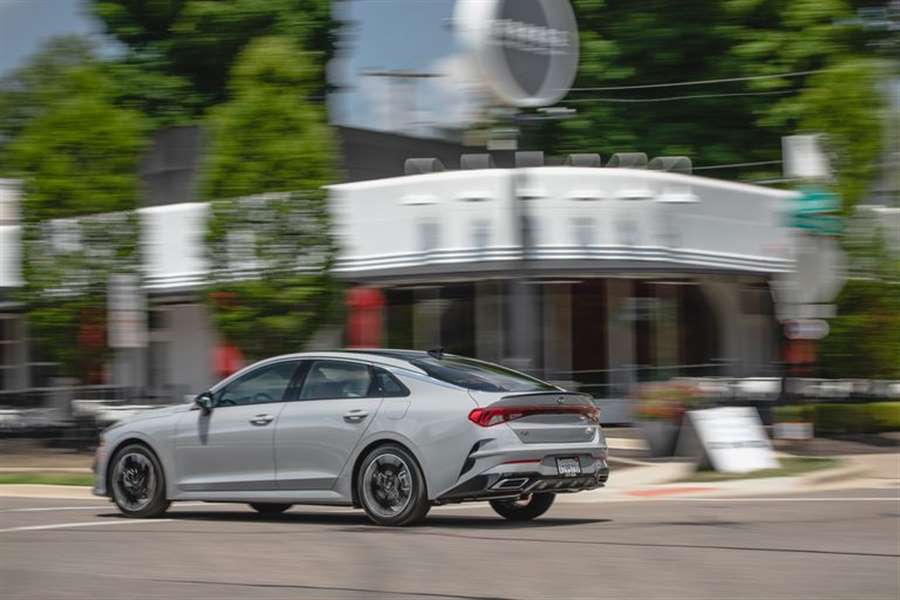
While the styling pleases eyes, the K5 is satisfying in many other ways. The base engine is a 180-hp turbocharged 1.6-liter four shared with the Sonata, and it's paired to an eight-speed automatic—no rubber-band CVT here. Shifts are smooth and quick, and the right gears are called up without any fuss. Low-end torque feels more abundant than its peak of 195 pound-feet at 1500 rpm indicates, and the turbo makes itself felt right away. Stomp it and the K5 gets to 60 in 7.0 seconds.
Venture beyond 5000 rpm and the engine moans, something you won't hear in an Accord. Driven more sedately, the K5 hums 67 decibels of sound into the cabin at 70 mph. All GT-Line and EX models have the same suspension tuning as the base K5, but they use 18-inch wheels with wider Pirelli all-season tires than the entry trim's 16s. Sharp impacts expose a lack of isolation. While not a deal breaker, it's worth noting that an Accord sops up the same hits with less coarseness. It's likely the shorter sidewalls of the 18-inch wheels and the one-size-fits-all tuning are to blame. The steering is both unerringly stable at highway speeds and deft and responsive when you're sawing through a canyon road or interesting on-ramp.
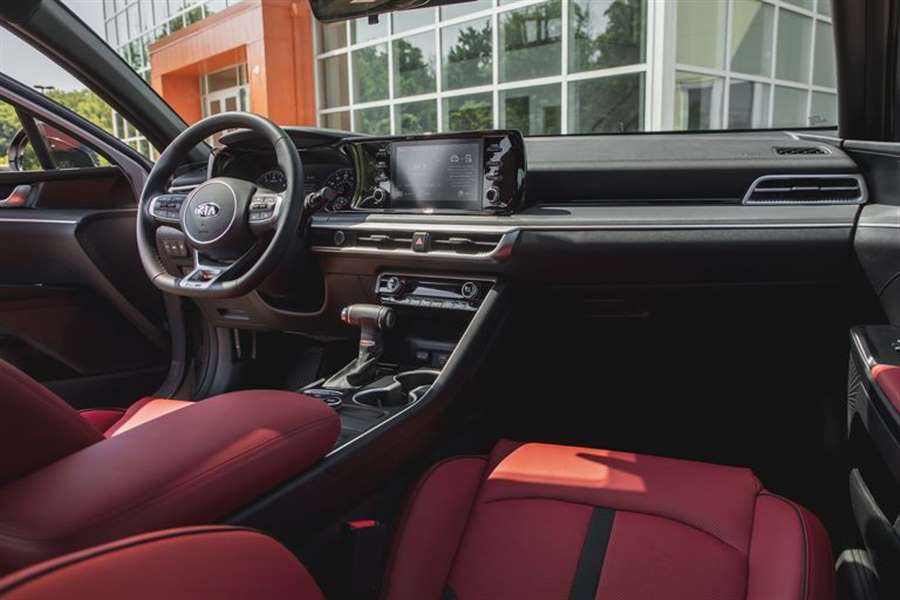
A radically angled windshield lends a sports-car mood to the driving experience, and the seating position is excellent. Rear-seat space is generous and comfortable. A 10.3-inch touchscreen is available on some trim levels, but the GT-Line comes with an 8.0-inch screen. Both sprout out of the dash and are flanked by physical buttons that make switching between functions easy. The instrument panel has a BMW-ness to it, and material quality throughout the cabin is good. Apple and Android phone mirroring is wireless on all models with the standard 8.0-inch infotainment screen, but strangely, you'll need a cable if you upgrade to the 10.3-incher.
The K5 inches closer to the Accord's ability to deliver everyday joy. A bit of suspension tuning to increase isolation and refinement would give it the manners to match its designer looks.
Source: caranddriver.com

